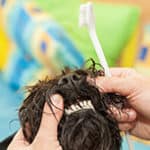Sciuridae is the rodent family encompassing various animals, including prairie dogs, chipmunks, groundhogs, flying squirrels, tree squirrels, and marmots.
Regardless of the species, all squirrels possess similar teeth, which serve specific functions. So, here is all you need to know about squirrel teeth.
Squirrels have strong and evergrowing teeth that need natural trimming via touch foods.
However, due to the nature of their teeth, you need to look out for dental issues like overgrowth, etc. That is because once the teeth trouble begins, it can cause starvation and early death.
Let us explore the unique features of squirrel teeth, their purpose, and the challenges they may encounter. We will also examine how rescue organizations identify and manage dental problems in squirrels.
Before you scroll further down this guide, check out these other animal-related articles: Boxer Dog Grinding Teeth? and How Long Do Labradoodle Puppies Teethe?.
Table of Contents
Squirrel Teeth Type

All rodent family members, including squirrels, possess teeth that continue to grow throughout their lives.
These teeth have a tough layer of enamel. Underneath the enamel lies a layer of cementum, followed by the tooth’s dentin or pulp.
Squirrels’ molars resemble human molars, with an enamel-cementum-dentin structure and roots resembling human teeth.
However, squirrel incisors must multiply to accommodate their diet, resulting in a slightly different appearance than the molars and premolars.
Remarkably, squirrel incisors develop enamel beneath the gum line, continuously growing throughout the squirrel’s life. That ensures the squirrel can wear down its incisors naturally without risking losing them.
Quantity Of Teeth Squirrels Have

The dental anatomy of squirrels includes 22 teeth, except for the Eastern gray squirrel, which has two additional premolars and 24 teeth. Generally, all squirrel species possess four incisors, four premolars, and 12 molars.
Familiar with other rodents, squirrels lack canine teeth; instead, a gap, known as a diastema, is present between their incisors and premolars.
Molars
Aside from their four premolars, squirrels possess 12 molars not utilized for gnawing. Instead, they serve to grind down the tough foods squirrels consume.
In addition, squirrels have strong jaw muscles to complement their sizeable molars and cheek teeth with a substantial layer of enamel, preventing premature wear and tear.
Premolars

Typically, squirrels have four premolars that closely resemble their molars and are frequently referred to as “cheek teeth” due to their proximity to the jaw.
Incisors
Squirrels possess four front teeth, which are elongated, slender, and chisel-shaped.
These teeth are vital for gnawing, and the upper and lower incisors must align precisely. Otherwise, the teeth cannot wear down, leading to overgrowth.
Surprisingly, a squirrel’s lower jaw, or mandible, comprises two distinct bones on either side of the jaw.
In addition, the two bottom incisors are joined by a single ligament, providing the squirrel with the flexibility required to move its lower incisors from side to side for various activities.
What Do Squirrels Use Their Teeth For?

Firstly, gnawing is one of the primary activities that squirrels engage in.
They must chew to access the required food and shred material for their bedding. However, the incisors serve an additional significant role: self-defense.
Squirrels will protect their territory from other squirrels and, in rare instances, bite humans if they feel threatened or confined.
To crack open the tough nuts, seeds, and conifer cones they exist on, squirrels employ their strong cheek teeth.
Once there are cracks in the shells, their suitably adapted molars make short work of the nutmeat or seed inside.
Reason Behind Orange Teeth

The bright orange or yellow front teeth of squirrels are one of their most recognizable features.
However, what is the reason behind their teeth being orange? Squirrel teeth are orange, as they are only white during infancy.
The enamel that covers the teeth is responsible for the orange coloration.
The top incisors are usually darker than the bottom ones because the bottom incisors rest behind the front incisors. As a result, the enamel on the front incisors wears away more quickly, leaving a lighter color.
Common Dental Issues That Squirrels Face

Squirrels can experience dental issues with their incisors at any point in their lives, but they are especially vulnerable as babies.
That is due to their oversized heads, which can put them at risk of falling from high places.
In addition, falls can result in broken incisors, and if these teeth grow back unevenly, they can cause malocclusion.
Odontoma
Tumors in the tooth root of the upper incisors, known as odontomas, can also afflict squirrels.
These growths can be caused by either traumatic injury, such as from falls, or captive squirrels chewing on cage bars during their early stages of development.
If left untreated, odontomas can be fatal, but with early detection, squirrels can get treatment from specialized professionals.
Malocclusion and Overgrowth

Misalignment of incisors, malocclusion, is a common dental issue in rodents. If the incisors are not aligned properly, they will not wear evenly and keep growing.
It may result in overgrowth, a condition that can cause the squirrel to lose its ability to eat, and if left untreated, may lead to death.
Fortunately, many squirrel rescue organizations provide veterinary care for squirrels in need.
Expert rodent veterinarians can examine the squirrel, diagnose overgrown teeth, and administer the necessary treatment, including trimming or extracting teeth.
However, it is crucial to remember that professionals should only do dental care for squirrels. If you find a squirrel that requires dental care, don’t try to trim its teeth yourself. Instead, contact a veterinary specialist.
FAQs About Squirrel’s Teeth

What type of teeth do squirrels have?
Squirrels have four long, thin, chisel-shaped incisors at the front of their mouth, followed by four premolars and 12 molars.
The premolars are nearly identical to the molars and form a group as “cheek teeth.” Like all rodents, squirrels do not have canine teeth; instead, they have a gap between their incisors and premolars called a diastema.
Do squirrels have sharp teeth?
Squirrels have sharp front teeth called incisors that are long and chisel-shaped, which they use for gnawing. They also have molars and premolars used for grinding and crushing food.
The sharpness of their teeth allows them to break open hard shells of nuts and seeds.
Additionally, squirrels have strong jaw muscles to go with their big molars, making their teeth and jaw powerful tools. So, in short, yes, squirrels have sharp teeth.
Do squirrels have back teeth?
Yes, squirrels have back teeth, also known as molars. They have 12 molars located toward the back of their mouth. The molars are to grind and chew tough pulp foods that squirrels eat, such as nuts and seeds.
How do squirrels trim their teeth in the wild?
Squirrels in the wild keep their teeth trimmed through their constant gnawing on complex objects such as nuts, seeds, and tree branches.
The gnawing action wears down their front incisors and keeps them from overgrowing.
The wild and fibrous foods they eat also help to wear down their cheek teeth, which are for grinding and crushing their food.
Additionally, squirrels may chew on objects such as rocks or bones to help keep their teeth in good condition.
What happens if a squirrel bites you?
If a squirrel bites you, you should immediately clean the wound with soap and water and seek medical attention if the injury is deep or infected.
While squirrels can carry diseases like rabies, the risk of contracting a disease from a squirrel bite is generally low.
However, taking precautions and monitoring the wound for any signs of infection, such as redness, swelling, or discharge, is essential.
It’s also important to note that squirrels may bite if they feel threatened or cornered sometimes, so it’s best to give them plenty of space and avoid approaching or handling them.
Do squirrels have teeth?
Yes, squirrels have teeth. They have four long, thin, chisel-shaped incisors at the front of their mouth that are vital for gnawing.
In addition, they have premolars and molars towards the back of their mouth that are for grinding and chewing food.
Do squirrel bites hurt?
Yes, squirrel bites can hurt. While squirrels are typically not aggressive toward humans, they may bite if they feel threatened, cornered, or trapped.
Squirrel bites can vary in severity depending on the force of the bite and the location of the bite.
A squirrel bite may cause pain, swelling, and redness, potentially leading to infection if not properly cleaned and treated.
Therefore, seeking medical attention if a squirrel bites you is essential to ensure proper treatment and prevent complications.
How do squirrel teeth get overgrown?
Squirrel teeth can become overgrown if their incisors do not line up properly and wear down correctly.
The incisors of a squirrel continue to grow throughout their lives, but they wear down naturally as the squirrel gnaws on complex objects.
However, if the incisors are not aligned correctly, they may not wear down properly, resulting in overgrowth.
That can be due to various factors such as genetics, injury, malnutrition, or a lack of complex objects to gnaw on.
In addition, overgrown teeth can be painful, making it difficult for squirrels to eat, leading to malnutrition and even death if left untreated.
Do squirrels file their teeth?
No, squirrels do not file their teeth themselves. Their teeth naturally wear down as they gnaw on complex objects such as nuts and branches and eat their regular diet.
If a squirrel’s teeth become overgrown, it is a sign of a dental problem and requires veterinary attention.
What do normal squirrel teeth look like?
Normal squirrel teeth are long, sharp, and chisel-shaped. They have four large incisors at the front of their mouth for gnawing, four premolars, and six molars in the back for grinding and crushing food.
The incisors are usually orange due to the teeth’ enamel coating.
The teeth should have proper alignment to wear down evenly as the squirrel chews and gnaw on various objects.
The teeth should also not be overgrown or misaligned, as this can lead to dental problems for the squirrel.
Conclusion For “Squirrel Teeth Guide: Everything You Need To Know”

In conclusion, all squirrels, including prairie dogs, chipmunks, groundhogs, flying squirrels, tree squirrels, and marmots, have teeth that continue to grow throughout their lives.
Their dental anatomy comprises four incisors, four premolars, and 12 molars, except the Eastern gray squirrel, which has two additional premolars.
Squirrels use their teeth primarily for gnawing, self-defense, and cracking open tough nuts, seeds, and conifer cones.
Their incisors, critical for chewing, overgrow and are continuously worn down to prevent overgrowth. Therefore, it is essential to remember that dental care for squirrels is just as vital as for any other animal.
If you find this guide, “Squirrel Teeth Guide: Everything You Need To Know,” informative and helpful, you can check out these other animal-related articles from our team:
You can learn more about this animal by watching “Top 20 Amazing Facts About Squirrels” down below:




